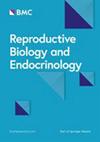hCG 触发后血清雌二醇水平显著下降,补充雌二醇对黄体支持的影响:一项前瞻性随机对照试验
IF 4.2
2区 医学
Q1 ENDOCRINOLOGY & METABOLISM
引用次数: 0
摘要
本研究旨在评估在黄体酮基础上添加 4 毫克戊酸雌二醇以支持黄体对试管婴儿周期妊娠率的影响,该试管婴儿周期采用长方案,在 hCG 触发后黄体血清雌二醇水平降低。这项前瞻性随机对照试验是在一家公立三级医院生殖中心进行的,共有 241 名患者参加了试验,这些患者在取卵后血清雌激素水平显著下降。参加者要么在标准黄体酮的基础上每天服用 4 毫克戊酸雌二醇,要么只服用标准黄体酮以支持黄体。E2组与对照组的持续妊娠率没有明显差异(56.6% 对 52.2%,绝对妊娠率差异 (RD) 为 4.4%,95% CI -0.087 至 0.179,P = 0.262)。同样,两组的活产率、植入率、临床妊娠率、早期流产率和严重OHSS率也相当。值得注意的是,E2 组没有生化流产,与对照组形成显著对比(0.0% vs. 10.7%,RD -10.7%,95% CI -0.178 to -0.041,P = 0.000)。在囊胚期类别中,E2 组的临床妊娠率明显高于对照组(75.6% vs. 60.8%,RD 14.9%,95% CI 0.012 to 0.294,P = 0.016)。在黄体酮黄体支持中添加 4 毫克戊酸雌二醇不会影响胚胎移植周期中的持续妊娠率,在使用长方案时,hCG 触发后血清雌二醇水平会显著下降。但是,它可以减少生化流产,并对囊胚移植周期的临床妊娠率产生积极影响。ChiCTR1800020342.本文章由计算机程序翻译,如有差异,请以英文原文为准。
Effect of estradiol supplementation on luteal support following a significant reduction in serum estradiol levels after hCG triggering: a prospective randomized controlled trial
This study aimed to evaluate the impact of adding 4 mg estradiol valerate to progesterone for luteal support on pregnancy rates in IVF cycles following a long protocol with reduced luteal serum estradiol levels post-hCG triggering. The prospective randomized controlled trial was conducted at a public tertiary hospital reproductive center with 241 patients who experienced a significant decrease in serum estrogen levels post-oocyte retrieval. Participants received either a daily 4 mg dose of estradiol valerate in addition to standard progesterone or standard progesterone alone for luteal support. The ongoing pregnancy rate did not show a significant difference between the E2 group and the control group (56.6% vs. 52.2%, with an absolute rate difference (RD) of 4.4%, 95% CI -0.087 to 0.179, P = 0.262). Similarly, the live birth rate, implantation rate, clinical pregnancy rate, early abortion rate, and severe OHSS rate were comparable between the two groups. Notably, the E2 group had no biochemical miscarriages, contrasting significantly with the control group (0.0% vs. 10.7%, RD -10.7%, 95% CI -0.178 to -0.041, P = 0.000). In the blastocyst stage category, the clinical pregnancy rate was notably higher in the E2 group compared to the control group (75.6% vs. 60.8%, RD 14.9%, 95% CI 0.012 to 0.294, P = 0.016). Adding 4 mg estradiol valerate to progesterone for luteal support does not affect the ongoing pregnancy rate in embryo transfer cycles using a long protocol with a significant decrease in serum estradiol levels after hCG triggering. However, it may reduce biochemical miscarriages and positively impact clinical pregnancy rates in blastocyst embryo transfer cycles. ChiCTR1800020342.
求助全文
通过发布文献求助,成功后即可免费获取论文全文。
去求助
来源期刊

Reproductive Biology and Endocrinology
医学-内分泌学与代谢
CiteScore
7.90
自引率
2.30%
发文量
161
审稿时长
4-8 weeks
期刊介绍:
Reproductive Biology and Endocrinology publishes and disseminates high-quality results from excellent research in the reproductive sciences.
The journal publishes on topics covering gametogenesis, fertilization, early embryonic development, embryo-uterus interaction, reproductive development, pregnancy, uterine biology, endocrinology of reproduction, control of reproduction, reproductive immunology, neuroendocrinology, and veterinary and human reproductive medicine, including all vertebrate species.
 求助内容:
求助内容: 应助结果提醒方式:
应助结果提醒方式:


